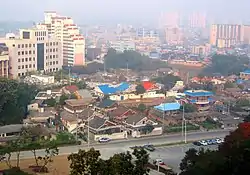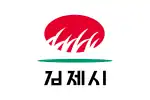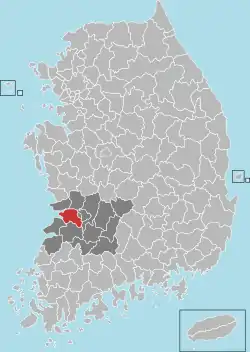Gimje
Gimje (Korean pronunciation: [kim.dze]) (Gimje-si) is a city in North Jeolla Province, South Korea.
Gimje
김제시 | |
|---|---|
| Korean transcription(s) | |
| • Hangul | 김제시 |
| • Hanja | 金堤市 |
| • Revised Romanization | Gimje-si |
| • McCune-Reischauer | Kimje-si |
 | |
 Flag  Emblem of Gimje | |
 Location in South Korea | |
| Coordinates: 35°48′06″N 126°53′20″E | |
| Country | |
| Region | Honam |
| Administrative divisions | 1 eup, 14 myeon, 4 dong |
| Government | |
| • mayor | Seong-ju Jeong (정성주) |
| Area | |
| • Total | 545.19 km2 (210.50 sq mi) |
| Population (November, 2022) | |
| • Total | 88,479 |
| • Density | 160/km2 (420/sq mi) |
| • Dialect | Jeolla |
| Time zone | UTC+9 (Korea Standard Time) |
| Area code | +82-63 |
History
The Gimje area is located on the "great plains" of Korea and has been cultivated since ancient times. Nations of early date ascended in the year 200. The Baekje Kingdom invaded and incorporated several small mahan states in the 13th year of King Onjo's reign. The Baekje Kingdom changed its name to Byeogol, but when is not clear.
In the Joseon dynasty, Gimje first appeared in the year 1466 when Sejo of Joseon ruled. He promoted Gimje to an independent county. In 1628, Gwanghaegun of Joseon combined the nearby district of Mangyeong District into Gimje County.[1]
The Baekje Kingdom was ruined by the Tang and Silla Kingdoms, and the Unified Silla Kingdom changed the city's name to Gimje city.
The Goryeo dynasty promoted Gimje city to Gimje District in the 21st year of King Injong’s reign.
City government has always highly regarded and promoted the cultivation of rice and other crop species. From the Baekje Kingdom through the 21st century, Gimje has been one of the best areas for growing rice.
Climate
| Climate data for Gimje (1993–2020 normals) | |||||||||||||
|---|---|---|---|---|---|---|---|---|---|---|---|---|---|
| Month | Jan | Feb | Mar | Apr | May | Jun | Jul | Aug | Sep | Oct | Nov | Dec | Year |
| Average high °C (°F) | 4.3 (39.7) |
7.0 (44.6) |
12.4 (54.3) |
18.7 (65.7) |
24.3 (75.7) |
27.9 (82.2) |
30.4 (86.7) |
31.4 (88.5) |
27.3 (81.1) |
21.6 (70.9) |
14.1 (57.4) |
6.5 (43.7) |
18.8 (65.8) |
| Daily mean °C (°F) | −0.4 (31.3) |
1.7 (35.1) |
6.1 (43.0) |
12.2 (54.0) |
18.1 (64.6) |
22.4 (72.3) |
26.0 (78.8) |
26.6 (79.9) |
21.7 (71.1) |
15.3 (59.5) |
8.6 (47.5) |
1.8 (35.2) |
13.3 (55.9) |
| Average low °C (°F) | −4.5 (23.9) |
−2.8 (27.0) |
1.0 (33.8) |
6.7 (44.1) |
12.9 (55.2) |
18.6 (65.5) |
22.7 (72.9) |
23.1 (73.6) |
17.6 (63.7) |
10.1 (50.2) |
3.8 (38.8) |
−2.4 (27.7) |
8.9 (48.0) |
| Average precipitation mm (inches) | 23.1 (0.91) |
29.9 (1.18) |
40.6 (1.60) |
69.9 (2.75) |
78.1 (3.07) |
117.4 (4.62) |
246.8 (9.72) |
240.9 (9.48) |
115.7 (4.56) |
52.4 (2.06) |
45.8 (1.80) |
29.3 (1.15) |
1,089.9 (42.91) |
| Average precipitation days (≥ 0.1 mm) | 6.8 | 5.0 | 6.3 | 6.7 | 7.3 | 7.8 | 11.9 | 11.5 | 7.5 | 5.4 | 7.0 | 7.1 | 90.3 |
| Source: Korea Meteorological Administration[2] | |||||||||||||
Horizon Festival
Gimje is known as the region where the sky meets the ground, hence the festival of horizon or 'jipyeongseon.' It is held at Byeokgolje area, and more than one million tourists visit it each year. Gimje Horizon Festival hosts a wide range of programs including Samullori (traditional percussion quartet) contest, rural landscape drawing contest, celebratory performances, street parade, Ssireum (wrestling), and traditional weddings.[3] Gimje is the only region where Koreans can see the horizon from a landlocked area. The festival was appointed an Excellent Festival for 4 years between 2004 and 2008. It also provides city residents a chance to experience traditional farming methods.[4]
Twin towns – sister cities
Gimje is twinned with:
 Kikuchi, Kumamoto, Japan (1985)
Kikuchi, Kumamoto, Japan (1985) Nantong, Jiangsu, China (1997)
Nantong, Jiangsu, China (1997) Gumi, North Gyeongsang, South Korea (1998)
Gumi, North Gyeongsang, South Korea (1998) Donghae City, Gangwon, South Korea (1999)
Donghae City, Gangwon, South Korea (1999)
People from Gimje
- Masutatsu Oyama, Zainichi Korean Karate master, founder of Kyokushin Karate (Real Name: Choi Yeong-eui, Hangul: 최영의, Choe Yeong-ui)
- Sin Chang-won (Hangul: 신창원), notorious South Korean criminal
- Casanova Wong, South Korean martial artist (Taekwondo), martial arts actor and film producer (Real Name: Kim Yong-ho, Hangul: 김용호, Gim Yong-ho)
- Lee Jung-hyun (Hangul: 이정현), South Korean actress, singer and K-pop idol
- Kim Se-jeong (Hangul: 김세정), South Korean actress, singer, dancer and K-pop idol, former member of K-pop girlgroups I.O.I, gugudan (in which she was the leader of the group), and the second gugudan's subgroup, gugudan SeMiNa.
References
- History of Gimje county was originally from city English page. http://www.gimje.go.kr/foreign/english/sub1/sub1.jsp%5B%5D
- "Climatological Normals of Korea (1991 ~ 2020)" (PDF) (in Korean). Korea Meteorological Administration. Archived from the original (PDF) on 29 January 2022. Retrieved 7 June 2023.
- Gimje Horizon Festival (김제 지평선축제) - Official Korea Tourism Organization. english.visitkorea.or.kr. Archived from the original on 2013-09-12. Retrieved 2013-08-12.
- 김제 (2007-12-23). '지평선축제' 4년 연속 최우수축제 [The best festival in 4 years]. Yeonhap News.
